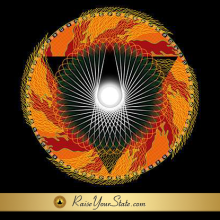“Drama is very important in life. You have to come on with a bang. You never want to go out with a whimper. Everything can have drama, if it’s done right.
Even a pancake.” ~ Julia Childs
What is your relationship to drama? And, I’m not talking about the pancake kind.
You know – the stories, opinions and emotions that send you up, pull you down and spin you all around, using a ton of energy.
Whether you see it on the news, experience it with your mate, or spend time with your long lost family, I suspect you do know about the drama that dissipates energy and creates distance in relationships.
Today, I want to share with you a model called the “drama triangle’. This dynamic is based on work by Stephen Karpman, M D., who wrote about it over 40 years ago.
Even if you don’t spend much time yourself playing any of these three roles I’ll describe – you most likely deal with people who do.
The three roles of the drama triangle are archetypal and easily recognizable in their extreme versions. Not so much in their subtler forms. They originate early in life when we take them on to survive in our family of origin and our culture.
Victims – The Wounded Inner Child
The stance of the victim is “poor me!” Victims see themselves as victimized, oppressed, powerless, helpless, hopeless, dejected, and ashamed. They often come across as “super-sensitive,” wanting kid glove treatment from others. They can deny any responsibility for their negative circumstances and deny possession of the power to change those circumstances.Trapped, stuck and powerless pervades this behavior.
A person in the victim role will look for a rescuer, a savior, to save them. Yet, if you reach out to a victim who feels stuck, they usually find ways to convince you that you can’t help them out of their powerless place.
When the victim role is set in place, there is little emotional resilience. They have real difficulties making decisions, solving problems, finding much pleasure in life, or understanding their self-perpetuating behaviors.
Rescuers – The marshmallow parent
The stance of the rescuer is “Let me help you!” Rescuers work hard to help and caretake other people. They even need to help other people to feel good about themselves, while neglecting their own needs.
Rescuers are classically co-dependent and enablers. They need victims to help and often can’t allow the victim to succeed or get better. They can use guilt to keep their victims dependent and feel guilty themselves if they are not rescuing somebody.
In terms of derailing resilience, rescuers are frequently harried, overworked, tired, caught in a martyr style while resentment festers underneath.
Persecutors – The Critical Parent
The stance of the persecutor is “It’s all your fault!” Persecutors criticize and blame the victim. They set strict limits, can be controlling, rigid, authoritative, angry and unpleasant. They keep the victim feeling oppressed through threats, rules and bullying.
In terms of resilience, persecutors can’t bend, can’t be flexible, can’t be vulnerable, can’t be human; they fear the risk of being a victim themselves. Persecutors yell and criticize but they don’t actually solve any problems or help anyone else solve the problem.
Of course, these are the most extreme versions of these three roles, but we can encounter people playing milder versions of these roles on a pretty regular basis.
What gives the drama triangle much of its power and significance is the recognition that people will switch roles and cycle through all three roles without ever getting out of the triangle. Drama persists!
Here is an example of how these roles play out:
Mom comes home from shopping to find Dad and Junior engaged in a battle. “Clean up your room or else,” (persecutor) Dad threatens. Mom immediately comes to Junior’s rescue. “Dad” she might say, “give the boy a break. He’s been at school all day.”
Any one of several possibilities might follow. Perhaps (persecutor) Dad, feeling victimized by Mom, will turn his wrath on her. In that case, he moves Mom from rescuer to victim. They then might do a few quick trips around the triangle with Junior on the sidelines.
Or maybe Junior joins Mom in a persecutory “Let’s gang up on Dad” approach, or then again, maybe Junior will turn on Mom, rescuing Dad with “Mind your own business, Mom. I don’t need your help!” So it goes, with endless variations, but nonetheless, pinging from corner to corner on the triangle. For many families, it’s the only way they know to interact.
The trap is that people act out these roles to meet personal (often unconscious) needs, rather than see the picture as a whole and take responsibility for their part in keeping the triangle going.
What’s needed is for anyone on the triangle to “wake up” to the roles they are playing repeatedly. One person shifting out of their role can catalyze the others to shift out of roles and behaviors.
Each role on the drama triangle has its own payoffs.
- Victims get to be taken care of.
- Rescuers get to feel good by caretaking.
- Persecutors get to remain feeling superior to both victim and rescuer and avoid vulnerability.
However, the cost to perpetuate the drama that goes on with any of these behaviors is high. You miss out on the possibilities (and responsibilities) of healthy, resonant, resilient relationships.
If you find yourself in any of these dynamics and want specific tools to shift your drama scene, I know the way out. I can support you to step out of your role in order to break up the drama that these dynamics create.
If you are interested, contact me for an appointment at meetme.so/VictoriaAllen and we can work together to diffuse relationship drama.


Leave a Reply